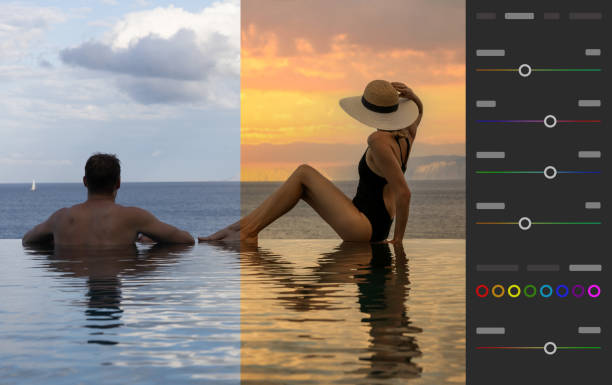In the realm of magazine publishing, the art of photo editing has undergone a significant transformation. From the days of manually adjusting photographs in dark rooms to the modern era of sophisticated digital tools, the journey of photo enhancement has been as riveting as it’s been revolutionary. This evolution isn’t merely about aesthetics; it’s intertwined with the very essence of storytelling.

Visuals play a paramount role in how stories are perceived, often invoking emotions, setting tones, or dictating the narrative’s pace. In this ever-evolving landscape, understanding the confluence of photo editing and storytelling becomes vital for anyone aiming to master the craft of compelling editorial content.
The Basics of Editorial Photography
At its core, editorial photography differs from other types because it serves a distinct purpose: to visually narrate a story or idea, often complementing the written word. It isn’t just about capturing a beautiful or striking image but about contextualizing it within the larger framework of the magazine’s narrative.
When readers flip through the pages, these images often grab their attention as a prelude to the story unfolding. High-quality photos are not just visually appealing, they enhance comprehension, retain readership, and elevate the reading experience. In a way, they act as silent narrators, conveying messages before words come into play.
The Power of AI in Modern Photo Editing
In today’s swiftly evolving digital landscape, the influence of Artificial Intelligence (AI) is undeniable. Among the many areas that AI has transformed, photo editing is a domain where this technology is making significant strides. Take, for instance, the technique of AI skin retouching. This innovation automates what was once a painstakingly meticulous process. By leveraging AI, editors can ensure smoother skin, eliminate imperfections, and achieve a flawless yet natural look, all with just a few clicks.
One software that exemplifies this AI-driven transformation is Luminar Neo. Designed with the modern editor in mind, it integrates powerful AI tools that expedite editing without compromising quality. With platforms like Luminar Neo, the possibilities for creating stunning editorial visuals are vast, and the hours spent on manual retouching are drastically reduced.
As we gaze into the future, it’s clear that the role of AI in photo editing is set to expand. With the convergence of machine learning models and increasingly sophisticated algorithms, future tools will refine editing techniques and reshape the essence of visual storytelling.
Balancing Act: Authenticity vs. Perfection
In today’s age of advanced photo editing tools, achieving the “perfect” image might seem like just a few clicks away. But what constitutes perfection? And does perfection sometimes come at the cost of losing authenticity?
Editorial photo editing often teeters between the quest for impeccable visuals and maintaining an image’s genuine essence. Over-editing, while it can polish and refine an image, can also strip away its inherent rawness and emotion. This raises the pivotal question: how much editing is too much?
Achieving a harmonious balance hinges on clearly understanding the image’s narrative intent. What story or emotion is the photograph trying to convey? Is it aiming to depict raw reality or a stylized interpretation? With tools like Luminar Neo, which offers AI-driven features, editors can make precise refinements. But using these advancements judiciously is crucial, ensuring that any enhancements serve the image’s story and not just aesthetic allure.
The mastery lies in recognizing that true perfection in editorial content isn’t just about a visually flawless image. It’s about capturing and preserving the heart of a story, where slight imperfections might add depth and relatability. By intertwining technical prowess with narrative integrity, editors can elevate their visuals, crafting stories that resonate on both an aesthetic and emotional level.
The Role of Editing in Visual Storytelling
At its essence, visual storytelling is the art of communicating narratives using visuals, often accompanied by text. It holds a unique power – to captivate, engage, and influence audiences in ways that words alone cannot. The role of editing within this realm is pivotal. It’s not just about making a picture look “better”; it’s about enhancing the visual to resonate with the intended emotion and message.
Techniques to Evoke Emotions
- Color Grading: Colors have the power to evoke specific emotions. Warmer tones can create feelings of nostalgia or warmth, while cooler tones can evoke calmness or melancholy.
- Cropping and Composition: An editor can emphasize specific elements by strategically cropping an image or adjusting its composition, creating focus, and drawing out desired emotions.
- Shadow and Highlight Manipulation: Shadows can add depth and mystery, while highlights can enhance vibrancy and life. Balancing these elements can guide the viewer’s emotional journey.
- Texture and Clarity: Enhancing or reducing textures can make images feel more rustic or dreamlike, respectively.
Leading the Reader’s Eye and Telling a Story
- Rule of Thirds: This fundamental technique places subjects off-center, creating dynamic, interesting visuals that guide the viewer’s gaze through the image.
- Depth of Field: By blurring the background (or foreground), editors can create a depth that focuses the viewer’s attention on a particular subject.
- Using Leading Lines: Roads, rivers, or any natural lines can lead the viewer’s eyes toward a focal point, creating a visual journey.
- Sequential Imagery: For longer narratives, images that follow a sequence can help depict progression, change, or the passage of time.
In visual storytelling, the editor’s role is akin to that of a film director. They set the scene, dictate the mood, and guide the viewer’s experience, ensuring the story unfolds seamlessly.
Conclusion
In the intricate dance of visual storytelling, editing is the choreographer. It’s not merely about refining an image but sculpting its narrative. Through thoughtful adjustments, editors can evoke deep emotions, guide perceptions, and craft compelling tales. As we recognize and harness this potential, we elevate the art of storytelling to new, visually resounding heights.
Published by HOLR Magazine.


